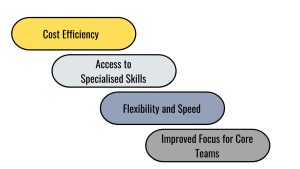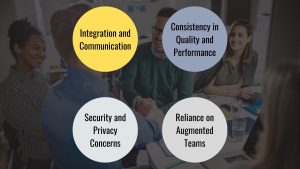Balancing Permanent and Augmented Team Members
Introduction In today’s dynamic business world, companies face constant changes in technology, customer demands, and market trends. To keep up, businesses must adapt quickly, ...

Introduction
In today’s dynamic business world, companies face constant changes in technology, customer demands, and market trends. To keep up, businesses must adapt quickly, especially in how they manage their workforce. For many, this means creating a scalable workforce that can handle varying workloads without sacrificing productivity or quality. One effective approach is to balance permanent employees with augmented team members, often brought in through workforce augmentation services.
In this article, we’ll look at how companies can effectively balance their permanent teams with augmented team members. We’ll look at the benefits of this approach, the challenges it creates, and strategies to make this model work smoothly. By mastering this balance, businesses can create a workforce that is flexible, resilient, and ready to meet changing demands.
Need for a Augmented Team Members
A scalable workforce is one that grows and shrinks based on business needs. With unpredictable market changes, companies can’t afford to rely solely on a permanent workforce. This is where team augmentation comes into play. By incorporating extended teams through workforce augmentation services, companies can quickly fill skill gaps or increase team size for specific projects.
Balancing a scalable workforce allows companies to:
- Adapt quickly to changing workloads
- Optimise costs by expanding only when needed
- Access specialised skills for unique tasks or projects
This approach not only increases flexibility, but also ensures that companies remain competitive in a rapidly changing environment.
Benefits of Balancing Permanent and Augmented Teams
Combining permanent staff with augmented team members offers several benefits.

Cost Efficiency
Maintaining a large permanent team is expensive. Salaries, benefits, and overhead add up quickly. By team augmentation, companies only pay for the additional skills they need, and only when they need them. This approach reduces long-term costs and eliminates the cost of onboarding and training permanent employees for temporary roles.
Access to Specialised Skills
Some projects require highly specialised knowledge that may not be available in-house. Hiring full-time specialists for short-term needs is impractical. Augmented teams offer access to top talent with specific skills, allowing companies to bring in experts on-demand and complete projects faster and more efficiently.
Flexibility and Speed
Business requirements can change at any time. By extending a team, companies can quickly scale up or down their workforce. This flexibility allows them to adapt to market changes, take advantage of new opportunities, or meet project deadlines without overloading their core team.
Improved Focus for Core Teams
Bringing in augmented team members to take on specific tasks or projects allows permanent employees to focus on their core responsibilities. This clear division of roles increases productivity and helps avoid burnout among full-time employees.
Challenges of Balancing Permanent and Augmented Team Members
While there are significant benefits to expanding your team, there are also challenges. Here’s what companies should be prepared for.

Integration and Communication
Extended teams often come from different backgrounds and may work remotely. Integrating them with your permanent team can be challenging. Communication barriers, cultural differences, and different work styles can lead to misunderstandings.
Consistency in Quality and Performance
Maintaining the same standard across permanent and extended staff is critical. Companies must ensure that extended team members understand the company’s quality standards, processes, and goals. Without a clear onboarding process, extended team members may struggle to achieve their desired results.
Security and Privacy Concerns
When working with external staff, data security becomes a priority. Sharing sensitive information with extended teams can pose risks if not managed properly. Companies need to develop robust data protection policies and ensure that all extended team members are aware of and adhere to security protocols.
Reliance on Augmented Teams
While staff augmentation services provide flexibility, relying too much on external teams can be problematic. Companies risk losing critical knowledge and experience if these enhanced team members leave or if they do not fully integrate with the permanent team.
Strategies for a Successful Balance Between Permanent and Augmented Team Members
To successfully balance the workforce of permanent and extended team members, companies should consider the following strategies.
Clear communication and defined roles
Clearly define the role of each team member, whether they are part of a permanent or extended team. Make sure everyone understands their responsibilities and how they contribute to the success of the project. Open communication promotes collaboration and prevents misunderstandings, creating a cohesive team environment.
Onboarding and training
Proper onboarding is essential for both permanent and extended team members. Introduce them to the company culture, processes, and tools they will need. Regular training can help extended team members meet company standards, especially if they are expected to work on multiple projects over a long period of time.
Create a mixed team culture
To prevent feelings of isolation, try to integrate extended teams with permanent staff. Hold team-building activities and encourage collaboration. The goal is to create a mixed team culture where everyone feels equally valued and committed to the success of the company.
Set up regular check-ins
Regular check-ins with recruiting team members help ensure they are on track and meeting project goals. These meetings provide an opportunity for recruiting team members to share feedback and address any issues they are experiencing. Managers can also track performance and make adjustments as needed.
Use technology to collaborate seamlessly
Collaboration tools are vital for managing a distributed workforce. Platforms like Slack, Microsoft Teams, and Asana keep communication clear and projects organised. Using these tools, companies can bridge the gap between regular and recruiting team members, ensuring smooth workflows and collaboration.
Create a knowledge management system
A knowledge management system helps capture valuable ideas and processes. It serves as a resource for regular and recruiting team members, especially if they need to quickly transfer knowledge or hire new employees. Documentation, guides, and process maps help ensure continuity even as team composition changes.
Regularly assess and optimise
Balancing permanent and augmented team members requires constant assessment. Regularly review team dynamics, project performance, and resource allocation. Collect feedback from both permanent and augmented team members to identify areas for improvement. This proactive approach helps improve balance and ensure the workforce remains scalable and efficient.

Choosing the Right Staff Augmentation Services
Finding the right staff augmentation provider can make a significant difference. Look for providers with a track record of providing reliable, skilled talent that fits well with your team’s culture. The right provider should also prioritise security and privacy, ensuring that data protection remains uncompromised.
Conclusion
In today’s fast-paced marketplace, building a scalable workforce is no longer optional. Balancing permanent employees with augmented team members allows companies to scale efficiently, access specialised skills, and respond flexibly to change. When done right, companies can create a harmonious, scalable workforce that thrives in the face of changing demands.
By thoughtfully using augmentation services, organisations can meet project requirements, optimise costs, and focus on their core goals. With careful planning and consistent assessment, they can create a workforce that is not only scalable, but also resilient and adaptable to any future challenges.